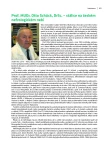Theralite and multiple myeloma
Authors:
Jana Lachmanová; Vladimír Tesař; Romana Ryšavá; Magdalena Bartková
Authors‘ workplace:
Klinika nefrologie 1. LF UK a VFN v Praze
Published in:
Vnitř Lék 2016; 62(Suppl 6): 9-13
Category:
Original Contributions
Předneseno ve zkrácené verzi na kongresu ČNS v Praze v roce 2016.
Overview
Multiple myeloma associated with an increased FLC production causes renal failure (cast nephropathy) requiring dialysis. Theralite is a dialyser with a high cut-off membrane (HCO) – with large size pores that allow permeability for substances of molecular masses up to 45 kDa. The FLC concentrations over hemodialysis will significantly decrease and if hematological treatment is also effective, the FLC production will significantly fall as well. The aim of this comprehensive therapy is to improve the renal functions to such an extent that a substantial removal of FLC (70–90 %) is reached in patients and even interruption of dialysis therapy (50–75 %). The number of HD with this membrane rather varies in individual patients according to the literature (e.g. an average of 12 HDs/per 1 patient – 3–45). Our cohort comprised 17 patients aged 38–71 years, with 9 HDs per 1 patient, 10 patients (59 %) stopped the dialysis therapy and 7 remained on the dialysis programme. FLC removal reached 87 % in the whole cohort after the completed HDs with Theralite, but it specifically reached 93 % in the patients without further dialysis therapy, as opposed to 75 % in those who continued to undergo HD. No patient died when receiving HD with Theralite, in 4 complications occurred without causing interruption of the therapy. We assume that monitoring FLC concentrations before each dialysis may be of prognostic significance for patients including the length of treatment with an HCO membrane. Close cooperation with a hematologist is necessary.
Key words:
cast nephropathy – FLC – HCO membrane – multiple myeloma – kidney failure – Theralite
Sources
1. Walther C, Podoll A, Finkel K. Treatment of acute kidney injury with cast nephropathy. Clin Nephrol 2014; 82(1): 1–6. Dostupné z DOI: <http://dx.doi.org/10.5414/CN108293>.
2. Tsakiris DJ, Stel V, Finne P et al. Incidence and outcome of patients starting renal replacement therapy for end stage renal disease due to multiple myeloma or light -chain deposition disease an ERA-EDTA Registry study. Nephrol Dial Transplant 2010; 25(4): 1200–1206. Dostupné z DOI: <http://dx.doi.org/10.1093/ndt/gfp679>.
3. Ryšavá R. Postižení ledvin u mnohočetného myelomu a novinky v léčbě. Postgraduální medicína 2015; 17(5): 489–498.
4. Heher EC, Rennke HG, Laubach JP et al. Kidney disease and multiple myeloma. Clin J Am Soc Nephrol 2013; 8(11): 2007–2017. Dostupné z DOI: <http://dx.doi.org/10.2215/CJN.12231212>.
5. Herrera GA, Sanders PW. Paraproteinemic renal diseases that involve the tubulo-interstitium. Contrib Nephrol 2007; 153: 105–115.
6. Cockwell P, Hutchinson C. Management options for cast nephropathy in multiple myeloma. Curr Opin Nephrol Hypertens 2010; 19(6): 550–555. Dostupné z DOI: <http://dx.doi.org/10.1097/MNH.0b013e32833ef72c>.
7. Hutchinson C, Batuman V, Behrens J et al. The pathogenesis and diagnosis of acute kidney injury in multiple myeloma. Nat Rev Nephrol 2011;8(1): 43–51. Dostupné z DOI: <http://dx.doi.org/10.1038/nrneph.2011.168>.
8. Hutchinson C, Bradwell A, Cook M et al. Treatment of acute renal failure secondary to multiple myeloma with Chemotherapy and extended High Cut Off hemodialysis. Clin J Am Soc Nephrol 2009; 4(4): 745–754.
9. Zanneti BA, Zamagni E, Santostefano M et al. Bortezomib-based therapy combined with high cut-off hemodialysis is highly effective in newly diagnosed multiple myeloma patients with severe renal impairment. Am J Hematol 2015; 90(7): 647–652. Dostupné z DOI:. <http://dx.doi.org/10.1002/ajh.24035>.
10. Hutchinson C, Cockwell P, Reid S et al. Efficient removal of immunoglobulin light chains for multimyeloma: in vitro and in vivo studies. J Am Soc Nephrol 2007; 18(3): 886–895.
11. Hutchinson C, Cockwell P, Basnayake K et al. Removal of free light chains by extended hemodialysis in patients with cast nehropathy: A phase 1/2 clinical trial. Nephrol Dial Transplant 2007; 22(Suppl 6): vi58.
12. Hutchinson CA, Cockwell P, Stringer S et al. Early reduction of serum-free light chains associates with renal recovery in myeloma kidney. J Am Soc Nephrol 2011; 22(6): 1129–1136. Dostupné z DOI: <http://dx.doi.org/10.1681/ASN.2010080857>.
13. Bradwell AR. Serum free light chain analysis. 4th ed. The Binding Site 2006. ISBN 978–0704425293.
14. Hutchinson C, Cook M, Heyne N et al. European trial of free light chain removal by extended haemodialysis in cast nephropathy (EuLite): A randomised control trial. Trials 2008; 9: 55. Dostupné z DOI: <http://dx.doi.org/10.1186/1745–6215–9-55>.
15. Orsag J, Pika T, Kosatíkova Z et al. Hemodialýza s použitím „high cut off“ membrán při selhání ledvin u mnohočetného myelomu – první zkušenosti. Klin Biochem Metab 2013; 21(42): 88–92.
16. Technology Brief update 2014 (november), register ID WP094. Foerster V. Theralite for treatment of renal failure in patients with multiple myeloma. Dostupné z WWW: <https://www.health.qld.gov.au/healthpact/docs/updates/WP094_update.pdf>.
Labels
Diabetology Endocrinology Internal medicineArticle was published in
Internal Medicine

2016 Issue Suppl 6
Most read in this issue
- Metabolic acidosis in chronic kidney disease
- Current options of treatment of hyponatremia
- Gitelman´s syndrome as common cause of hypokalemia and hypomagnesemia
- Osteoporosis – epidemiology and pathogenesis
